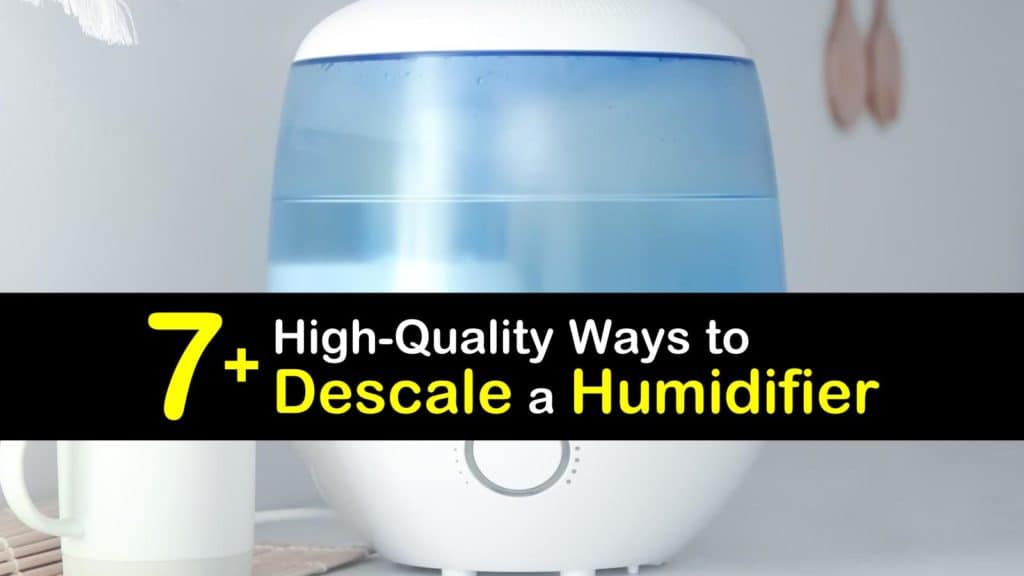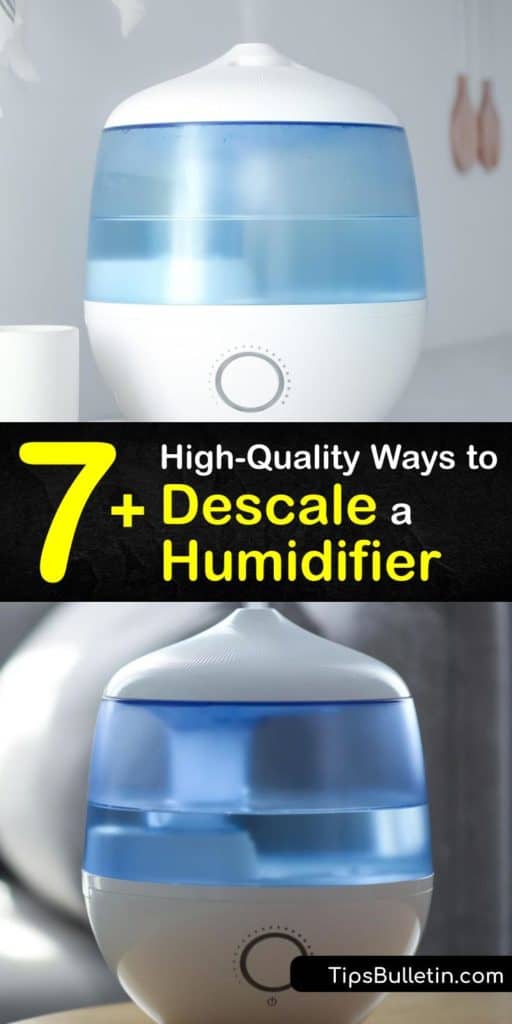Living in areas with cold, dry winters takes a significant toll on your skin and your home’s indoor air quality. One of the smartest things to do in cold regions is to invest in a humidifier for your home or bedroom. If you plan to do so, learning how to descale a humidifier is something that you’re going to have to take into consideration.
Humidifiers are fantastic for several reasons. Not only do these machines add moisture to the air inside your home, but they also help you fight static and protect you from some symptoms of the common head cold.
They even prevent your skin from drying out and painfully cracking after being exposed to hot, stale air from your furnace. Because humidifiers use a water basin to work, you have to know how to remove calcium deposits from a humidifier and how to prevent calcium buildup in humidifier.

What is a Humidifier?
Home humidifiers are small devices that emit water vapor or steam from a basin, and there are several types of humidifiers. Central humidifiers are built into your air conditioning system and humidify the entire home.
Ultrasonic humidifiers use ultrasonic vibration that emits a cool mist into the air and are known as a cool mist humidifier. Steam humidifiers use a heating element and vaporizer to create steam that goes into the air. The best way to clean a cool mist humidifier or a steam humidifier is the same.
The ideal humidity percentage of homes should be between 30 and 50 percent. When this percentage is too low or high, problems like dry skin, irritated nasal passages, itchy eyes, condensation on the walls and floors, and harmful bacteria growth occur.
How to Descale a Humidifier
All humidifiers contain a type of water tank that is generally filled with tap water. Tap water has large amounts of mineral deposits. Mineral buildup becomes noticeable when white, powdery substances start to form on the inside of the humidifier.
The buildup of calcium and limescale in humidifier is hard to remove if not taken care of for long periods. The minerals then get put into the air, which affects our home’s air health and irritates our lungs.
Find a High-Quality Brand
When shopping for a home humidifier, it’s often best not to take the cheapest route. Although more expensive doesn’t necessarily mean it works better, do the research and invest in a product that gives you the results you’re looking for.
Some of the best humidifier brands on the market today are Honeywell and Swish Swash.

Perform Regular Maintenance on Humidifiers
Unless you have a central humidifier, most do require a little bit of work. Regular maintenance of these machines includes emptying old water and refilling it with new, fresh water daily when possible.
This task is critical with cool-mist and ultrasonic humidifiers. Humidifiers should also be cleaned every three days for the best performance and for removing mineral deposits and film in the water tank.
Regular maintenance also includes changing the humidifier filters as often as possible. Check the manufacturer’s instructions to see how often you should replace the humidifier filter.
How to Remove Calcium Deposits from a Humidifier
Vinegar is the ideal home cleaner. Clean a faucet head with vinegar, or use it on your humidifier. The results are the same.
Descaling a humidifier isn’t too much work when you keep up on the cleanings. It is only after you allow the mineral to build up over long periods that requires extra arm muscle, and learning how to unclog a humidifier that has extensive buildup.
When starting to learn how to descale a humidifier, begin by unplugging the machine before you disassemble it. Pour about two cups of distilled white vinegar into the water tank and swish it around. Make sure the interior is completely wet.
Put the vinegar-filled tank onto its base and let the vinegar drain into the reservoir to loosen all the mineral buildup. Let the vinegar sit for 20 minutes.
Empty the vinegar from the machine and use an old toothbrush or soft-bristle brush to begin scrubbing all small crevices and any calcium deposits.
Wipe down small parts with more vinegar, and then rinse everything with fresh, clean water. Allow the humidifier to air dry before you reassemble it.
You can use this same procedure with vinegar or citric acid to clean a Keurig machine and coffee pot as well as the humidifier to eliminate buildup.
To descale a shower head with vinegar, put some vinegar in a heavy-duty plastic bag and secure it with a rubber band to the shower head. Let it sit in the vinegar overnight and scrub with a toothbrush in the morning.
Using Hydrogen Peroxide as a Cleanser
Hydrogen peroxide is a potent ingredient with antibacterial and antifungal properties. Creating a homemade peroxide and water solution dilutes the peroxide but still thoroughly cleans the entire machine. It works just as well to remove calcium buildup on a night guard and other personal items that could potentially grow calcium or bacteria.
Mix equal parts water and peroxide in a large bowl and pour the mixture into the water tank.
Allow the cleaning solution to drain into the reservoir and sit for 15 to 20 minutes so that it eats through or breaks down any grime before emptying the remainder of the solution from the tank and base. Rinse the humidifier and dry the excess water with a dry paper towel.
Put the Tank in the Dishwasher
Certain brands of humidifiers are somewhat dishwasher safe. The Honeywell brand allows you to wash both the water tank and tray in the dishwasher. Use liquid dishwashing soap and wash the pieces on a gentle cycle.
Remove the parts from the dishwasher once the cycle finishes and wipe away the remaining wet spots with a clean, dry cloth.
Be careful when using the dishwasher. If your tap water has a high mineral content, it may leave you with more calcium and limestone buildup than before.
Using Trusty Dish Soap
Dish soap is a long-time friend when it comes to cleaning up messes and challenging stains. To wash your humidifier with soapy water, fill a bowl with warm tap water and add a few drops of grease-fighting dish soap until there are lots of suds.
Dip a clean rag into the water. Ring out the excess and use the damp cloth to begin scrubbing away at the limescale buildup.
If the minerals won’t come off, fill the water tank with soapy water and let it sit for ten minutes before scrubbing it once more. When all the deposits are removed, rinse the machine under clean water and let it air dry.
How to Disinfect Your Humidifier
Some of the best cleaning tips use a bleach solution to cut through tough grime and for disinfecting hard surfaces. Bleach is one of the toughest ingredients to remove calcium deposits from a humidifier.
Mix the water and chlorine bleach in a large plastic bucket. Pour roughly half of the bleach solution into the water tank and make sure the entire inside is wet. Put the tank back on its base and let the bleach water drain into the humidifier’s reservoir.
Let the bleach work its magic for about 20 minutes. Empty the bleach water from the machine and rinse with clean water.
You may have to rinse more than once until the smell of the bleach disappears completely. Wipe the humidifier with a dry cloth and reassemble it for its next use.
How to Prevent Calcium Buildup in Humidifier
Preventing calcium, limestone, and other minerals from building up is vital for our overall health and the air quality in our homes.
Learning how to prevent calcium buildup in humidifier is the most effective way to ensure that we don’t irritate our lungs or breathe in particles that we shouldn’t be.
Keep the Tank Empty When Not in Use
Only refill your water tank and reservoir when you know that you’re going to use the humidifier. Standing water is a welcome mat for harmful bacteria growth and is the quickest way to create limescale buildup.
Replace the Filter
As mentioned before, replacing the filter is one of the most important preventative measures you can take. Most filters require replacement once every 30 to 60 days.
The best way to determine if you should replace a filter is to look for hard or crusty deposits from minerals. The filter should be free from rancid odors.
If the moisture output decreases on your humidifier, this is another strong indication that you need to replace the filter.
Provide a Deep Clean
Giving your humidifier a deep clean once every week is the minimum to attempt one of these cleaning methods. This time frame ensures that your machine stays free from grime and that your air is filled continuously with clean water vapor.
Use Distilled Water Instead of Tap
Tap water is what most people use in their humidifiers because that’s what they have. If you’re willing to invest a little more money in distilled water, this is a guaranteed way to reduce the amount of mineral buildup.
Tap water has minerals added to it, while distilled water has trace amounts, creating an automatic household descaler. The minerals in tap water encourage bacteria to grow, so using distilled water is well worth it when you take the machine’s lifespan into account.
Taking good care of your home’s humidifier ensures that you can use it with confidence for years. Those who don’t take care of their humidifiers end up spending more money in the long run because their machines stop working and don’t give them the results they’re looking for.
Learning skills like how to remove calcium deposits from a humidifier and how to prevent calcium buildup in humidifiers will make a world of difference in your overall health.

If learning how to descale a humidifier has kept your air quality high, share these cleaners for home humidifiers on Facebook and Pinterest.